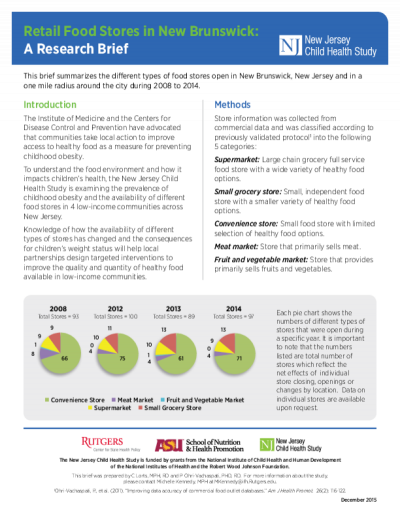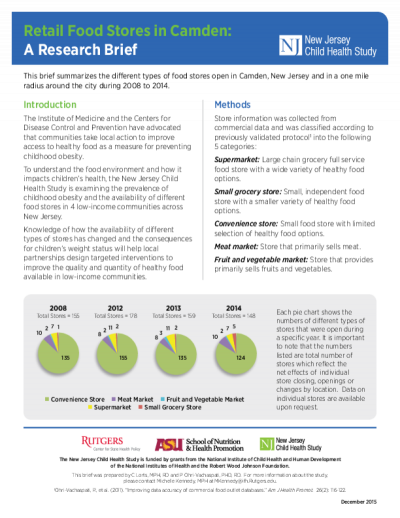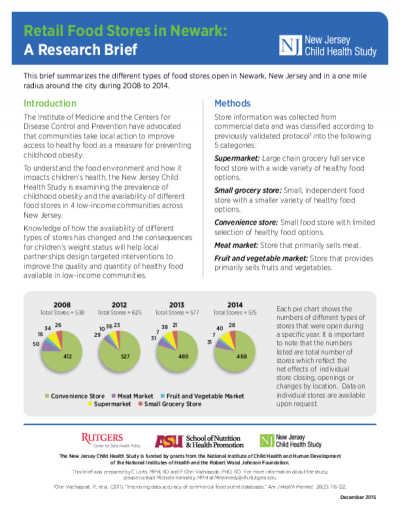
Many factors influence children’s health behaviors and health outcomes. The Social Ecological Model (SEM) groups these factors into interactive layers, creating a framework for understanding their influence and for designing interventions to achieve positive change. The layers of influence in the SEM include individual, interpersonal, organizational, community, and policy factors.


This brief summarizes the different types of food stores open in New Brunswick, New Jersey and in a one mile radius around the city during 2008 to 2014.

Many factors influence children’s health behaviors and health outcomes. The Social Ecological Model (SEM) groups these factors into interactive layers, creating a framework for understanding their influence and for designing interventions to achieve positive change. The layers of influence in the SEM include individual, interpersonal, organizational, community, and policy factors (see figure). The New Jersey Child Health Study (NJCHS) was designed to examine how specific layers of the SEM, particularly food and physical activity environments in schools and communities, affect obesity outcomes in children

This brief summarizes the different types of food stores open in Camden, New Jersey and in a one mile radius around the city during 2008 to 2014.

This brief summarizes the different types of food stores open in Newark, New Jersey and in a one mile radius around the city during 2008 to 2014.

This brief summarizes the different types of food stores open in Trenton, New Jersey and in a one mile radius around the city during 2008 to 2014.

Meatless Monday is an initiative that encourages actionable steps toward the reduction of meat consumption by asking participants to eat meat-free on Mondays. Many organizations, cities, schools, and correctional facilities have implemented Meatless Monday initiatives as a push to improve environmental sustainability, human health, and the welfare of animals. Such initiatives provide an opportunity to educate consumers on the health benefits of a plant-forward diet, the environmental impact of meat production, animal welfare issues, the innovation of non-meat proteins, and to engage stakeholders in gaining more control over their food choices. This report offers a summary of seven Meatless Monday initiatives throughout the U.S., highlighting best practices and notable challenges of implementing and maintaining such an initiative in three different contexts: local government, school systems, and non-profit or volunteer-led organizations. This report was conducted through an extensive look at previous research, news articles, and marketing materials, as well as interviews with stakeholders in six mid-sized U.S. cities.

Aims: to evaluate 1) the PA variation explained by work walkability, 2) the moderating effects of person-level characteristics to the relationship between PA and work walkability, and 3) the differences in the rate of change in PA over time by worksite walkability.
Methods: self-report and accelerometer measured PA at baseline (aim 1, 2); longitudinal accelerometer PA during the initial 56 days of a behavioral intervention (aim 3). Adults were generally healthy and reported part- or full-time employment with a geocodeable address outside the home. Geographic Information Systems (GIS) measured walkability followed established techniques (i.e., residential, intersection, and transit densities, and land-use-mix).
Results: On average, worksite walkability did not show direct relationships with PA (aim 1); yet certain person-level characteristics moderated the relationships: sex, race, and not having young children in the household (aim 2). During 56 days of intervention, the PA rate of change over time showed no evidence of a moderating effect by worksite walkability.
Discussion: Worksite walkability was generally not shown to relate to the overall PA. However, specific subgroups (women, those without young children) appeared more responsive to their worksite neighborhood walkability. Prior literature shows certain demographics respond differently with various BE exposures, and this study adds a potentially novel moderator of interest regarding young children at home. Understanding who benefits from access to walkable BE may inform targeted interventions and policy to improve PA levels and foster health equity.

Investigation one revealed a moderate-to-large effect size for school-based interventions (n=10) increasing CVF (g=0.75; 95%CI [0.40-1.11]). Multi-level interventions (g=.79 [0.34-1.25]) were more effective than interventions focused on the individual (g=0.67 [0.12-1.22]). In investigations two and three children (78.3% Hispanic; mean ± SD age 53.2±4.5 months) completed a mean ± SD 3.7±2.3 PACER laps and 19.0±5.5 CSMP criteria. Individual and family factors associated with PACER laps included child sex (B=-0.96, p=0.03) and age (B=0.17, p<0.01), parents’ promotion of inactivity (B=0.66, p=0.08) and screen time (B=0.65, p=0.05), and parents’ concern for child’s safety during physical activity (B=-0.36, p=0.09). Child age (B=0.47, p<0.01) and parent employment (B=2.29, p=0.07) were associated with CMSP criteria. At the ECEC level, policy environment quality (B=-0.17; p=0.01) was significantly associated with number of PACER laps completed. Outdoor play environment quality (B=0.18; p=0.03), outdoor play equipment total (B=0.32; p<0.01) and screen time environment quality (B=0.60; p=0.02) were significantly associated with CMSP criteria. Researchers, ECEC teachers and policy makers should promote positive environmental changes to preschool-aged children’s family and ECEC environments, as these environments have the potential to improve CVF and GLS more than programs focused on the child alone.